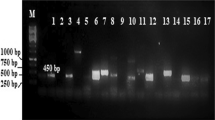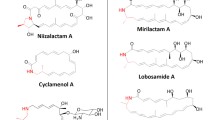Abstract
As bacterial natural products have been proved to be the most important source of many therapeutic medicines, the need to discover novel natural products becomes extremely urgent. Despite the fact that the majority of bacterial species are yet to be cultured in a laboratory setting, and that most of the bacterial natural product biosynthetic genes are silent, “metagenomics technology” offers a solution to help clone natural product biosynthetic genes from environmental samples, and genetic engineering enables the silent biosynthetic genes to be activated. In this work, a type II polyketide biosynthetic gene cluster was identified from a soil metagenomic library and was activated by over-expression of a SARP regulator gene in the gene cluster in Streptomyces hosts. A new tetracenomycin type compound tetracenomycin Y was identified from the fermentation broth. This study shows that metagenomics and genetic engineering could be combined to provide access to new natural metabolites.



Similar content being viewed by others

References
Jung WS, Kim ES, Kang HY, Choi CY, Sherman DH, Yoon YJ (2003) Site-directed mutagenesis on putative macrolactone ringsize determinant in the hybrid pikromycin–tylosin polyketidesynthase. J Microbiol Biotechnol 13:823–827
Handelsman J, Rondon MR, Brady SF, Clardy J, Goodman RM (1998) Molecular biological access to the chemistry of unknown soil microbes: a new frontier for natural products. Chem Biol 5(10):R245-249. https://doi.org/10.1016/s1074-5521(98)90108-9
Katz M, Hover BM, Brady SF (2016) Culture-independent discovery of natural products from soil metagenomes. J Ind Microbiol Biotechnol 43(2–3):129–141. https://doi.org/10.1007/s10295-015-1706-6
Owen JG, Charlop-Powers Z, Smith AG, Ternei MA, Calle PY, Reddy BV, Montiel D, Brady SF (2015) Multiplexed metagenome mining using short DNA sequence tags facilitates targeted discovery of epoxyketone proteasome inhibitors. Proc Natl Acad Sci USA 112(14):4221–4226. https://doi.org/10.1073/pnas.1501124112
Wang Z, Forelli N, Hernandez Y, Ternei M, Brady SF (2022) Lapcin, a potent dual topoisomerase I/II inhibitor discovered by soil metagenome guided total chemical synthesis. Nat Commun 13(1):842. https://doi.org/10.1038/s41467-022-28292-x
Li L, MacIntyre LW, Ali T, Russo R, Koirala B, Hernandez Y, Brady SF (2021) Biosynthetic interrogation of soil metagenomes reveals metamarin, an uncommon cyclomarin congener with activity against Mycobacterium tuberculosis. J Nat Prod 84(4):1056–1066. https://doi.org/10.1021/acs.jnatprod.0c01104
Weissman KJ (2009) Chapter 1 introduction to polyketide biosynthesis. Complex enzymes in microbial natural product biosynthesis, part B: polyketides, aminocoumarins and carbohydrates. Academic Press, Cambridge, pp 3–16
Zhang Z, Pan HX, Tang GL (2017) New insights into bacterial type II polyketide biosynthesis. F1000Research 6:172. https://doi.org/10.12688/f1000research.10466.1
Gillespie DE, Brady SF, Bettermann AD, Cianciotto NP, Liles MR, Rondon MR, Clardy J, Goodman RM, Handelsman J (2002) Isolation of antibiotics turbomycin a and B from a metagenomic library of soil microbial DNA. Appl Environ Microbiol 68(9):4301–4306. https://doi.org/10.1128/AEM.68.9.4301-4306.2002
Feng Z, Kallifidas D, Brady SF (2011) Functional analysis of environmental DNA-derived type II polyketide synthases reveals structurally diverse secondary metabolites. Proc Natl Acad Sci USA 108(31):12629–12634. https://doi.org/10.1073/pnas.1103921108
Kallifidas D, Kang HS, Brady SF (2012) Tetarimycin A, an MRSA-active antibiotic identified through induced expression of environmental DNA gene clusters. J Am Chem Soc 134(48):19552–19555. https://doi.org/10.1021/ja3093828
Stevenson LJ, Bracegirdle J, Liu L, Sharrock AV, Ackerley DF, Keyzers RA, Owen JG (2021) Metathramycin, a new bioactive aureolic acid discovered by heterologous expression of a metagenome derived biosynthetic pathway. RSC Chem Biol 2(2):556–567. https://doi.org/10.1039/d0cb00228c
Brady SF, Simmons L, Kim JH, Schmidt EW (2009) Metagenomic approaches to natural products from free-living and symbiotic organisms. Nat Prod Rep 26(11):1488–1503. https://doi.org/10.1039/b817078a
Lewis K, Epstein S, D’Onofrio A, Ling LL (2010) Uncultured microorganisms as a source of secondary metabolites. J Antibiot (Tokyo) 63(8):468–476. https://doi.org/10.1038/ja.2010.87
Liu Z, Zhao Y, Huang C, Luo Y (2021) Recent advances in silent gene cluster activation in Streptomyces. Front Bioeng Biotechnol 9:632230. https://doi.org/10.3389/fbioe.2021.632230
Baltz RH (2010) Streptomyces and Saccharopolyspora hosts for heterologous expression of secondary metabolite gene clusters. J Ind Microbiol Biotechnol 37(8):759–772. https://doi.org/10.1007/s10295-010-0730-9
Liu G, Chater KF, Chandra G, Niu G, Tan H (2013) Molecular regulation of antibiotic biosynthesis in Streptomyces. Microbiol Mol Biol Rev 77(1):112–143. https://doi.org/10.1128/MMBR.00054-12
Bibb MJ (2005) Regulation of secondary metabolism in Streptomycetes. Curr Opin Microbiol 8(2):208–215. https://doi.org/10.1016/j.mib.2005.02.016
Chen Y, Wendt-Pienkowski E, Shen B (2008) Identification and utility of FdmR1 as a Streptomyces antibiotic regulatory protein activator for fredericamycin production in Streptomyces griseus ATCC 49344 and heterologous hosts. J Bacteriol 190(16):5587–5596. https://doi.org/10.1128/JB.00592-08
Beck C, Gren T, Ortiz-Lopez FJ, Jorgensen TS, Carretero-Molina D, Martin Serrano J, Tormo JR, Oves-Costales D, Kontou EE, Mohite OS, Mingyar E, Stegmann E, Genilloud O, Weber T (2021) Activation and identification of a Griseusin cluster in Streptomyces sp. CA-256286 by employing transcriptional regulators and multi-omics methods. Molecules. https://doi.org/10.3390/molecules26216580
Wang S, Gao X, Gao Y, Li Y, Cao M, Xi Z, Zhao L, Feng Z (2017) Tetracycline resistance genes identified from distinct soil environments in China by functional metagenomics. Front Microbiol 8:1406. https://doi.org/10.3389/fmicb.2017.01406
Brady SF (2007) Construction of soil environmental DNA cosmid libraries and screening for clones that produce biologically active small molecules. Nat Protoc 2(5):1297–1305. https://doi.org/10.1038/nprot.2007.195
Wawrik B, Kerkhof L, Zylstra GJ, Kukor JJ (2005) Identification of unique type II polyketide synthase genes in soil. Appl Environ Microbiol 71(5):2232–2238. https://doi.org/10.1128/AEM.71.5.2232-2238.2005
Hutchinson CR (1997) Biosynthetic studies of daunorubicin and tetracenomycin C. Chem Rev 97:2525–2535
Qiao X, Gan M, Wang C, Liu B, Shang Y, Li Y, Chen S (2019) Tetracenomycin X exerts antitumour activity in lung cancer cells through the downregulation of cyclin D1. Mar Drugs. https://doi.org/10.3390/md17010063
Osterman IA, Wieland M, Maviza TP, Lashkevich KA, Lukianov DA, Komarova ES, Zakalyukina YV, Buschauer R, Shiriaev DI, Leyn SA, Zlamal JE, Biryukov MV, Skvortsov DA, Tashlitsky VN, Polshakov VI, Cheng J, Polikanov YS, Bogdanov AA, Osterman AL, Dmitriev SE, Beckmann R, Dontsova OA, Wilson DN, Sergiev PV (2020) Tetracenomycin X inhibits translation by binding within the ribosomal exit tunnel. Nat Chem Biol 16(10):1071–1077. https://doi.org/10.1038/s41589-020-0578-x
Walsh CT, Fischbach MA (2010) Natural products version 2.0: connecting genes to molecules. J Am Chem Soc 132(8):2469–2493. https://doi.org/10.1021/ja909118a
Rutledge PJ, Challis GL (2015) Discovery of microbial natural products by activation of silent biosynthetic gene clusters. Nat Rev Microbiol 13(8):509–523. https://doi.org/10.1038/nrmicro3496
Mao D, Okada BK, Wu Y, Xu F, Seyedsayamdost MR (2018) Recent advances in activating silent biosynthetic gene clusters in bacteria. Curr Opin Microbiol 45:156–163. https://doi.org/10.1016/j.mib.2018.05.001
Jiang ZB, Ren WC, Shi YY, Li XX, Lei X, Fan JH, Zhang C, Gu RJ, Wang LF, Xie YY, Hong B (2018) Structure-based manual screening and automatic networking for systematically exploring sansanmycin analogues using high performance liquid chromatography tandem mass spectroscopy. J Pharm Biomed Anal 158:94–105. https://doi.org/10.1016/j.jpba.2018.05.024
Nguyen JT, Riebschleger KK, Brown KV, Gorgijevska NM, Nybo SE (2021) A BioBricks toolbox for metabolic engineering of the tetracenomycin pathway. Biotechnol J. https://doi.org/10.1002/biot.202100371
Yoon YJ, Beck BJ, Kim BS, Kang HY, Reynolds KA, Sherman DH (2002) Generation of multiple bioactive macrolides by hybrid modular polyketide synthases in Streptomyces venezuelae. Chem Biol 9(2):203–214. https://doi.org/10.1016/s1074-5521(02)00095-9
Hong JS, Park SH, Choi CY, Sohng JK, Yoon YJ (2004) New olivosyl derivatives of methymycin/pikromycin from an engineered strain of Streptomyces venezuelae. FEMS Microbiol Lett 238(2):391–399. https://doi.org/10.1016/j.femsle.2004.08.002
Xue Y, Sherman DH (2001) Biosynthesis and combinatorial biosynthesis of pikromycin-related macrolides in Streptomyces venezuelae. Metab Eng 3(1):15–26. https://doi.org/10.1006/mben.2000.0167
Jung WS, Lee SK, Hong JS, Park SR, Jeong SJ, Han AR, Sohng JK, Kim BG, Choi CY, Sherman DH, Yoon YJ (2006) Heterologous expression of tylosin polyketide synthase and production of a hybrid bioactive macrolide in Streptomyces venezuelae. Appl Microbiol Biotechnol 72(4):763–769. https://doi.org/10.1007/s00253-006-0318-5
Martin JF, Liras P (2010) Engineering of regulatory cascades and networks controlling antibiotic biosynthesis in Streptomyces. Curr Opin Microbiol 13(3):263–273. https://doi.org/10.1016/j.mib.2010.02.008
Funding
This study was supported by the National Natural Science Foundation of China under Grant Number 31770049.
Author information
Authors and Affiliations
Contributions
ZF designed the experiments; LN, YG and QJ carried out the experiments; MC performed NMR measurements; SW, YL, and ZF analyzed the experimental results; ZF and LN wrote the manuscript. All authors have read and agreed to the published version of the manuscript.
Corresponding author
Ethics declarations
Conflict of interest
The authors declare no conflict of interest.
Additional information
Publisher's Note
Springer Nature remains neutral with regard to jurisdictional claims in published maps and institutional affiliations.
Supplementary Information
Below is the link to the electronic supplementary material.
Rights and permissions
Springer Nature or its licensor holds exclusive rights to this article under a publishing agreement with the author(s) or other rightsholder(s); author self-archiving of the accepted manuscript version of this article is solely governed by the terms of such publishing agreement and applicable law.
About this article
Cite this article
Nie, L., Cao, M., Ji, Q. et al. Regulated Expression of an Environmental DNA-Derived Type II Polyketide Gene Cluster in Streptomyces Hosts Identified a New Tetracenomycin Derivative TCM Y. Curr Microbiol 79, 336 (2022). https://doi.org/10.1007/s00284-022-03039-5
Received:
Accepted:
Published:
DOI: https://doi.org/10.1007/s00284-022-03039-5



